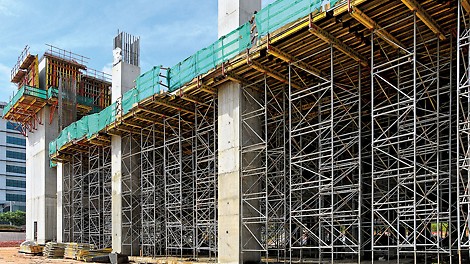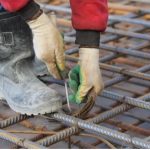Construction sites change fast, but safety always stays first. One smart way to stay safe is by using shoring in construction. This strong support holds walls, soil, and buildings steady. It lets workers dig deep or fix tall buildings without fear of collapse.
Let’s unpack how shoring works, why people use it, and what tools help builders stay safe and strong.
What Is Shoring in Construction?
Shoring means holding something firm so it won’t fall. It grabs hold of walls or ground when it can’t stand alone. Crews set it up when digging near roads, houses, or other buildings. It also helps during repairs or changes to old structures.
Shoring steps in to stop walls from sliding and soil from spilling. This keeps workers safe while they shape, fix, or dig.
When and Why to Use Shoring?
Shoring joins a site when the ground turns weak or open. You’ll spot it during trench work, basement digging, or when holding up shaky walls. Builders choose it to keep everything balanced and protect workers around it.
Shoring works best when:
- Trenches go deep near other structures
- Walls need help during a big change
- Foundations grow or shift
Good shoring holds fast, saves time, and stops buildings from breaking down.
Types of Shoring Systems
Shoring systems come in many styles. Each one grips a job differently, based on what the soil feels like and how deep the digging goes.
1. Hydraulic Shoring
- This system squeezes metal parts using fluid. It spreads pressure evenly and fits well into deep, narrow holes.
2. Soldier Pile and Lagging
- Tall metal beams dig into the earth. Wooden panels sit between them to stop dirt from sliding in.
3. Sheet Piling
- Metal sheets snap together like puzzle pieces. They form a wall that pushes back water and soft dirt.
4. Pneumatic Shoring
- This uses air instead of fluid. It feels lighter and sets up quickly.
Understanding the C60 Shoring System
The C60 shoring system grabs attention because it bends to different jobs. It carries heavy weight and holds tall slabs or wide frames. Crews snap parts together fast, which saves time and effort.
Its pieces click into place, stretch to different heights, and stay strong. When pressure climbs, C60 holds tight and refuses to budge.
How Shoring Interacts with Modular Scaffolding?
Modular scaffolding and shoring may look alike, but they serve different goals. Shoring grabs weight. Scaffolding helps people climb or reach.
They often share space, especially on busy sites. Together, they build support and safety for large tasks like lifts, repairs, or wall builds.
Because of their design, they click together and fill the gaps that others can’t. This makes jobs faster, safer, and easier to handle.
Safety Factors in Shoring
Good shoring never guesses — it measures. Engineers study weight, soil, and pressure before they build. They then shape the shoring system to handle more than needed.
Safety checks include:
- Watching the system every day
- Testing how much it can carry
- Locking it down at every spot
Loose shoring may crack or tip, which brings danger. That’s why trained workers must guard it, read the signs, and check every bolt.
Shoring Versus Scaffolding: Key Differences
Shoring and scaffolding may look alike, but they play very different roles. One holds the earth. The other lifts people.
| Feature | Shoring | Scaffolding |
| Purpose | Holds ground or buildings | Holds workers and tools |
| What It Carries | Heavy loads | Lightweight and people |
| Time of Use | Long and steady | Often short and flexible |
| How It Moves | Stiff with a set shape | Easy to change with parts |
This table helps spot the difference, so teams don’t confuse the two.
Choosing the Right Shoring Plan
Every site speaks its own story. Shoring must match that tale. Before choosing, teams must check the land, load, and job type.
Here’s what makes a good shoring plan:
- Check how deep the excavation is by examining the land.
- Find out how much pressure the Earth puts on objects.
- Choose a system that stays stable.
- Train the team to secure it.
- Regularly check for weak spots.
Planning keeps workers safe and jobs on track.
Shoring and Scaffolding Rental Considerations
Many jobs rent gear instead of buying. Picking scaffolding rental or shoring tools means you get what you need without long-term storage.
When renting:
- Ask to see safety checks and papers
- Make sure parts fit your current setup
- Call for help if tools feel odd
Using the right scaffolding rental means less waste, smarter space use, and safer steps.
Shoring and the Malaysian Construction Scene
In busy places like Scaffolding Malaysia, shoring holds a firm place. Cities grow tall and fast. Buildings press close together. Shoring keeps these tall towers from shifting.
Malaysia uses both local ideas and global tools. Builders follow set rules and safety laws. These steps help teams avoid danger and finish strong.
Environmental Considerations in Shoring Design
Shoring doesn’t just protect buildings — it also helps the planet. Some systems reuse parts. Others shrink the space they need. Both steps keep nature safe.
Smarter shoring means:
- Less waste from job to job
- Clean materials that last
- Better shapes that use less land
Eco-friendly builders choose clean tools and tight systems. These choices keep water, trees, and animals safe.
Innovations in Shoring Technology
New designs keep growing. Shoring today moves quicker, weighs less, and stands taller than before.
Cool upgrades include:
- Stronger metals that weigh less
- Connectors that snap in seconds
- Sensors that send alerts if things shift
These updates guard workers and speed up every build. As tech moves forward, expect machines to help even more.
Training and Compliance
Even smart tools need wise hands. Crews must learn how to build, check, and fix shoring systems.
Proper training helps workers:
- Set each part at the right angle
- Check bolts and pins
- Write down test results and fix what’s wrong
Rules change by country, but the goal stays the same — safety. Each person must know the system they use and follow clear steps every day.
Final Thoughts
Shoring gives quiet strength. It grips the ground and walls, letting teams work safely above or below. In every project, shoring in construction plays a hidden but powerful part.
Systems like the C60 shoring system carry the load while crews move and shape buildings. Along with tools like modular scaffolding, they form the backbone of progress.
Smart choices, clear training, and strong teamwork keep every project safe. Whether you’re digging deep or reaching high — when the base holds, the rest stands firm.
FAQs
The three main types are Hydraulic Shoring, Sheet Piling, and Soldier Pile and Lagging, each supporting structures in different conditions.
Shoring provides temporary structural support, preventing collapse during construction, repair, or excavation work.
H or I beam shoring uses vertical steel beams with horizontal supports to reinforce deep excavations and prevent soil movement.
The safety factor typically ranges from 1.5 to 2, ensuring structures remain stable under expected loads.








